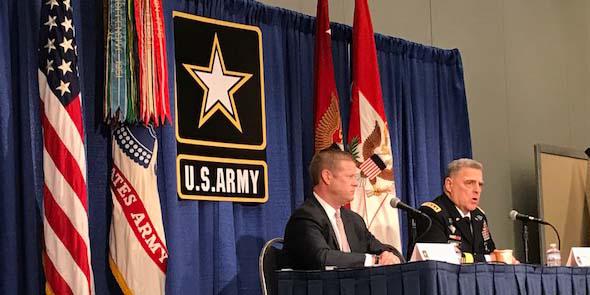Army to Tackle 'Significant' Modernization
Faced with aging equipment and vehicles from a bygone era, the Army is set to modernize by standing up a new command to transform its acquisition processes, among other things. It is one of the Army’s most significant restructuring efforts in the last 40 years. The need for modernization is coming from an "eroding" competitive advantage, and the evolving needs of a modern—and future—battlefield.
“We do not have time to waste,” implored Gen. Mark Milley, USA, U.S. Army chief of staff, at the Association of the U.S. Army (AUSA) Annual Meeting in Washington, D.C., on October 9. “Our challenges are growing in scale and are in every domain of warfare: land, maritime, air, cyber and space.”
The new command will consolidate the acquisition process, bringing Army modernization “under one roof,” Acting Secretary of the Army Ryan McCarthy explained. The new command will come from within the existing force structure; the Army does not anticipate any related civilian job losses or movements.
Lt. Gen. Edward Cardon, USA, will spearhead the planning and development of the new command. Gen. Cardon will present recommendations to his commanders after a 120-day task force wrestles with ideas on “the ultimate form and function” of the new command, Gen. Milley said.
The modernization platform will involve an examination of requirements and talent management. To facilitate rapid prototype development from “idea to delivery,” an improved process would compress the time needed to develop requirements with stakeholders and bring advanced technologies to the forefront. It will cover the Army’s futures work, concept development, requirements determination and prioritization.
“Anything that has been around for 40 years will be looked at,” McCarthy said. The Army will improve existing work processes and “reinvent others, though details are still to be decided.”
On the talent side, the transformation “has to start at the top, from leadership,” McCarthy said.
In order of importance to the Army, the modernization will encompass six areas:
- Long-range precision fire capability to restore the Army’s dominance in range, munitions and targeting.
- A next-generation combat vehicle, along with other close combat capabilities, in manned, unmanned and optionally manned vehicles equipped with the most modern firepower, protection, mobility and power generation.
- Future vertical lift platforms to attack, lift and perform reconnaissance in manned, unmanned and optionally manned survivable platforms.
- An Army network: hardware, software and infrastructure sufficiently mobile and expeditionary to support a modern command, fight cohesively in any environment, and offer offensive and defensive cyber capabilities.
- Air and missile defense capabilities to protect the force from modern and advanced air/missile threats.
- Soldiers: increase lethality of warfighters in all fundamental areas, including shooting, moving, communicating, protecting and sustaining.
“Our Army must regain our overmatch and competitive advantage against emerging threats, competitors, and advisories,” Gen. Milley said.





Comments